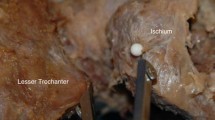Abstract
Objective
To examine the effect of external hip rotation on ischiofemoral (IF) and quadratus femoris (QF) spaces using real-time kinematic MRI, with the hypothesis that hips with IF and QF space narrowing have distinct motion patterns compared with control hips.
Materials and methods
This prospective study was IRB-approved and complied with HIPAA guidelines. We recruited women (≥ 18 years) with and without ischiofemoral impingement to undergo kinematic MRI of the hips. A kinematic imaging protocol using T2-HASTE was performed beginning at maximal internal rotation followed by active external hip rotation. The duration of each acquisition was 30 s, providing 8 images/3 s. IF and QF spaces, and femoral metaphyseal and lesser trochanter centroid coordinates were measured on sequential images. Hips were classified as controls or narrowed based on IF and QF space thresholds and compared statistically throughout motion stages.
Results
The cohort comprised 12 women (24 hips; 10 control and 14 narrowed hips) aged 58 ± 10 years. External rotation caused IF space reduction of 59% in narrowed hips versus 41% in control hips. QF space decreased 71% in narrowed hips versus 50% in control hips. IF and QF spaces differed significantly between groups only when external rotation exceeded the neutral position (P < 0.02 for both). The lesser trochanter terminated more posteriorly in narrowed hips compared with controls (P = 0.03).
Conclusions
Kinematic MRI during external hip rotation in women with narrowed and control hips reveals dynamic differences in IF and QF spaces and lesser trochanter terminal position.








Similar content being viewed by others
References
Torriani M, Souto SCL, Thomas BJ, Ouellette H, Bredella MA. Ischiofemoral impingement syndrome: an entity with hip pain and abnormalities of the quadratus femoris muscle. AJR Am J Roentgenol. 2009;193:186–90.
Patti JW, Ouellette H, Bredella MA, Torriani M. Impingement of lesser trochanter on ischium as a potential cause for hip pain. Skelet Radiol. 2008;37:939–41.
Johnson KA. Impingement of the lesser trochanter on the ischial ramus after total hip arthroplasty. Report of three cases. J Bone Joint Surg Am. 1977 Mar;59(2):268–9.
Tosun O, Algin O, Yalcin N, Cay N, Ocakoglu G, Karaoglanoglu M. Ischiofemoral impingement: evaluation with new MRI parameters and assessment of their reliability. Skelet Radiol. 2012;41:575–87.
Ali AM, Teh J, Whitwell D, Ostlere S. Ischiofemoral impingement: a retrospective analysis of cases in a specialist orthopaedic centre over a four-year period. Hip Int J Clin Exp Res Hip Pathol Ther. 2013;23(3):263–8.
Bredella MA, Azevedo DC, Oliveira AL, Simeone FJ, Chang CY, Stubbs AJ, et al. Pelvic morphology in ischiofemoral impingement. Skelet Radiol. 2014 Nov:249–53.
Carro LP, Hernando MF, Cerezal L, Navarro IS, Fernandez AA, Castillo AO. Deep gluteal space problems: piriformis syndrome, ischiofemoral impingement and sciatic nerve release. Muscles Ligaments Tendons J. 2016 Sep;6(3):384–96.
Atkins PR, Fiorentino NM, Aoki SK, Peters CL, Maak TG, Anderson AE. In vivo measurements of the ischiofemoral space in recreationally active participants during dynamic activities: a high-speed dual fluoroscopy study. Am J Sports Med. 2017 Oct;45(12):2901–10.
Finnoff JT, Bond JR, Collins MS, Sellon JL, Hollman JH, Wempe MK, et al. Variability of the ischiofemoral space relative to femur position: an ultrasound study. Am Acad Phys Med Rehabil. 2015;(April):1–8.
Singer A, Clifford P, Tresley J, Jose J, Subhawong T. Ischiofemoral impingement and the utility of full-range-of-motion magnetic resonance imaging in its detection. Am J Orthop Belle Mead NJ. 2014 Dec;43(12):548–51.
Singer AD, Subhawong TK, Jose J, Tresley J, Clifford PD. Ischiofemoral impingement syndrome: a meta-analysis. Skelet Radiol. 2015 Jun;44(6):831–7.
O’Brien SD, Bui-Mansfield LT. MRI of quadratus femoris muscle tear: another cause of hip pain. AJR Am J Roentgenol. 2007 Nov;189(5):1185–9.
Johnson AC, Hollman JH, Howe BM, Finnoff JT. Variability of ischiofemoral space dimensions with changes in hip flexion: an MRI study. Skelet Radiol. 2017 Jan;46(1):59–64.
Gómez-Hoyos J, Schröder R, Reddy M, Palmer IJ, Martin HD. Femoral neck anteversion and lesser trochanteric retroversion in patients with ischiofemoral impingement: a case-control magnetic resonance imaging study. Arthrosc J Arthrosc Relat Surg. 2016 Jan 1;32(1):13–8.
Goldberg-Stein S, Friedman A, Gao Q, Choi J, Schulz J, Fornari E, et al. Narrowing of ischiofemoral and quadratus femoris spaces in pediatric ischiofemoral impingement. Skelet Radiol. 2018 Nov;47(11):1505–10.
DiSciullo AA, Stelzer JW, Martin SD. Dynamic ischiofemoral impingement: case-based evidence of progressive pathophysiology from hip abductor insufficiency: a report of two cases. JBJS Case Connect. 2018 Dec;8(4):e107.
Shapiro LM, Gold GE. MRI of weight-bearing and movement. Osteoarthr Cartil. 2012 Feb;20(2):69–78.
Gómez-Hoyos J, Martin RL, Schröder R, Palmer IJ, Martin HD. Accuracy of 2 clinical tests for Ischiofemoral impingement in patients with posterior hip pain and endoscopically confirmed diagnosis. Arthrosc J Arthrosc Relat Surg. 2016 Jul 1;32(7):1279–84.
Funding
This study was funded by the MGH Department of Radiology Ralph Schlaeger Award (fund #230050).
Author information
Authors and Affiliations
Corresponding author
Ethics declarations
Conflict of interest
The authors declare that they have no conflict of interest.
Ethical approval
This study was IRB-approved and HIPAA compliant. All procedures performed in studies involving human participants were in accordance with the ethical standards of the institutional and/or national research committee and with the 1964 Helsinki declaration and its later amendments or comparable ethical standards.
Additional information
Publisher’s note
Springer Nature remains neutral with regard to jurisdictional claims in published maps and institutional affiliations.
Rights and permissions
About this article
Cite this article
Vicentini, J.R.T., Martinez-Salazar, E.L., Simeone, F.J. et al. Kinematic MRI of ischiofemoral impingement. Skeletal Radiol 50, 97–106 (2021). https://doi.org/10.1007/s00256-020-03519-4
Received:
Revised:
Accepted:
Published:
Issue Date:
DOI: https://doi.org/10.1007/s00256-020-03519-4




